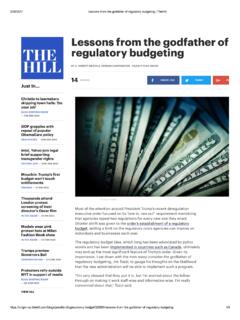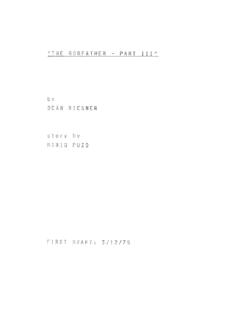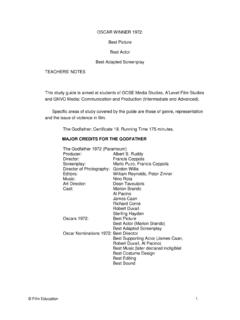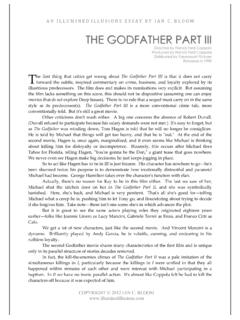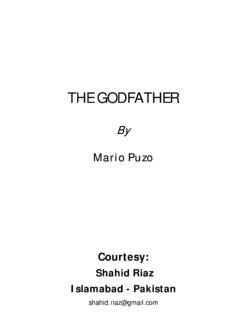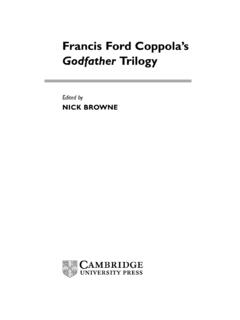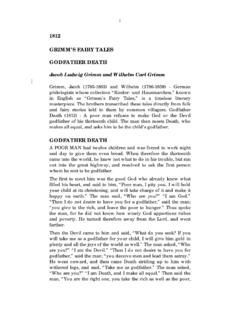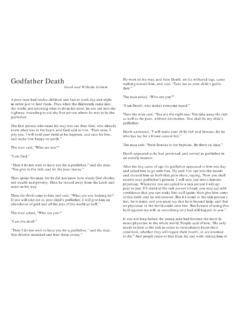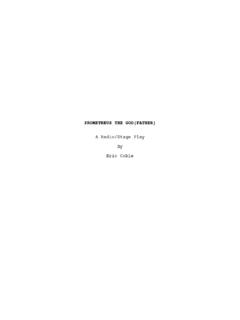Transcription of The Godfather, I and II: Patterns of Corruption - Weebly
1 "The godfather , i and ii ": Patterns of CorruptionAnthony AmbrogioNBC's 12-15 November 1977 telecast of God/flf/ier/and//in reedited,almost strictly chronological form, padded by the addition of scenes previouslycut, provided some insights into and confirmations of elements in the originalfilnis but didn't improve upon the initial structure of the pictures, particularlythe point-counterpoint of godfather IL The "complete novel for television"received disappointing ratings and even provoked some unfavorable criticalreassessment of the original iHmsA This lukewarm reception contrasts sharplyto the rave reviews godfather I and // received when first released in 1972 and1974, respectively. In fact, in 1974, many critics proclaimed // even betterthan its predecessor.
2 2 No doubt, IPs dual-plot structure contributed to thispreference; in //, the eariy history of Vito Corieone (nl Andolini), the God-father, adapted (and considerably embellished) from the unfilmed portions ofthe book, alternates with the continuing story of his son Michael (Al Pacino),the new godfather , taken up from where/ left it. Together, these two sectionsof // provide a fascinating framework, backward and forward in time, for theoriginal film. TV disrupted this framework; the godfather saga lost its epicquality by no longer beginning in medias res, with /.Despite the flashbacks, which comprise almost half of its running II was advertised as "Michael's story," and most critics were quickto see it as such, since it completes Michael's degeneration, begun in/, from anice ex-college boy, ex-war hero to a ruthless criminal.
3 (For that matter, / is Michael's story," too.) What critics failed to see was the artful way in whichthis transformation is accomplished.^For //'s modern section, director Francis Ford Coppola and his novelist Mario Puzo, the architects of godfather 1, simply went backto their drawing board, unroUed their old blueprints, and remade The God-father- with, however, several significant differences. They repeated thepattern they established in / while playing upon it numerous subtle, clevervariations in order to underline the further and complete Corruption of the(Corieone family: every important incident in the first film has a parallel in thesecond. Carlos Clarens was the first critic to catalogue in print several of the,35many parallel sequences between / and ZT, but he doesn't realize or stress thereason for these repetitions or note that they're imperfect repetitions-bydesign.)
4 ^ A complete catalogue and comparison of these inexact parallelswill reveal that reason and I begins with a large, outdoor celebration the wedding ofthe godfather 's daughter- while the godfather holds court inside, taking careof business and personal matters ( undertaker Bonasera's request that theGodfather avenge his daughter; godson Johnny Fontane's request for a part ina movie); godfather II begins the same way^the new godfather throws a galaoutdoor party in honor of his son's first communion and also attends tobusiness and personal matters ( Frankie Pentangeli's trouble with theGuzzardo brothers; his sister's parade of boyfriends and neglect of her child-ren). In each movie, we see that these initial matters are later acted upon; themost notable and most parallel of them are the intimidation of movieproducer Jack Woltz (John Marley) in / and of Senator Pat Geary (G.)
5 In //. Both the producer and the Senator after refusing to accedeto a Corleone request undergo ordeals which persuade them to change theirminds (the proverbial "offer they can't refuse"): they wake up stunned andbloody in bed. Woltz finds his Arabian stud horse's severed head under thecovers and Geary finds his favorite s & m prostitute cut up and dead underthe covers. (Clarens also mentions these parallels.)Early in /, there is an unsuccessful attempt on the godfather 's life; evenearlier in //, there is an attempt on the new godfather 's life. Both films pro-ceed from these points to tell tales of gang warfare and betrayal within theorganization and the family. Barzini (Richard Conte) surreptitiously leads theFive Families in opposition to the godfather 's organization in /; Hyman Roth(Lee Strasberg) duplicitously threatens Michael's operations in //.
6 ( In bothfilms, the factions ostensibly reconcile. In /, Vito Corleone (Marlon Brando)calls a meeting of the Five Families; they sit around a conference table whilethe godfather makes an impassioned plea for peace. This plea is apparentlyheeded, and everybody becomes "business" partners again, planning to go intodope dealing together. In //, Michael Corleone and Hyman Roth seem to forman uneasy alliance; they also become business partners and sit around a con-ference table with others, planning to divide up Cuba together. Of course,reconciliation in both films is only a smoke screen; violence between the twofactions erupts again before each film ends. Just as his father balked at be-coming involved with drug dealing, so Michael balks at investing money inRoth's Cuban scheme a smart move, since Castro's guerillas take over thecountry shortly afterward.)
7 However, in a reversal inspired by / whereinMichael prevents his father's attempted murder while Don Vito is recovering inthe hospital Michael is prevented in //, from having Roth murdered whileRoth is recovering in the hospital. Michael becomes the unscrupulous criminalhis father's opponents Corleone lieutenant Tessio (Abe Vigoda) betrays the family toBarzini in /," in //, another trusted lieutenant, Frankie Pentangeli (Michael ), Clemenza's successor, betrays the family to the government. Each paysthe price for his treachery. Similarly, brother-in-law Carlo Rizzi (Gianni Russo)betrays the family and sets up Sonny (James Caan) in /; in //, brother Fredo(John Cazale) betrays the family and sets up Michael.
8 In each case the delin-quent family member is given a grace period (no one touches Carlo while DonVito is alive, nor Fredo while Mama Corleone is alive) before he, like Tessioand Pentangeli, is eliminated. Both movies have as their climax a blood bath, aseries of multiple murders carried out under Michael's orders; he uses these36executions to consolidate his organization's power, ruthlessly wiping out"business" opponents (Barzini, the heads of the Five Families, and Moe Green[Alex Rocco] in /, Hyman Roth in //), traitors to the group (Tessio in I;Pentangeli in //), and the traitors to the family (Carlo in /; Fredo in //). Clarensalso notes this parallel slau^ the parallels do not stop there.
9 In /, Michael convincingly lies to hiswife, Kay (Diane Keaton), assuring her he had nothing to do with Carlo'sdeath, then ushers her out of his office and closes the door on her, effectivelyshutting her out of his life as he goes back to business. In U, the latent prob-lems in their relationship (re)surface, and her resentment over his refusal to golegitimate causes her to leave him. Exerting his Godfatherly authority, Michaelretains custody of their children. On one of her clandestine visits to see them,Kay tarries too long trying to get her son to kiss her goodbye. He is on theverge, about to come embrace her, when Michael returns to find Kay on thethreshold. He goes to the door and quietly, firmly, shuts it in her face.
10 Thisgesture is a repetition of his closing her out in /, but it takes on added weighthere because of the different circumstances and has a note of finality to , we do not see Kay again in //.As is obvious, Coppola and Puzo clothe their retelling of / in differentterms, disguising the similarities between the two films by using differentlocales (Florida, Cuba, and more of Nevada than in /) and the latei^model cars,hair styles, and fashions of the fifties in //, and by adding to // a variety ofcontemporary detail (the Cuban revolution, the Kefauver-like Senate sub-committee investigation) all to obscure its thematic and narrative duplicationof /. Besides returning to / for their inspiration, Coppola and Puzo also returnto the book, incorporating flashbacks of the early life and career of VitoCorleone (here played by Robert DeNiro), which helps to contribute to thedeceptive "new look" of //.
